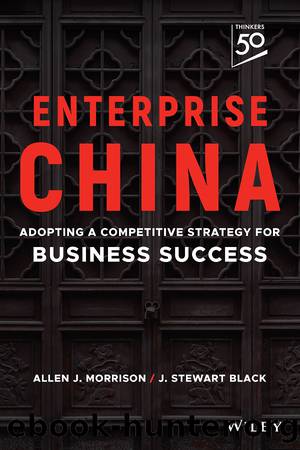Enterprise China: Adopting a Competitive Strategy for Business Success by J. Stewart Black & J. Stewart Black

Author:J. Stewart Black & J. Stewart Black [Morrison, Allen J. & Black, J. Stewart]
Language: eng
Format: epub
ISBN: 9781394153435
Publisher: Wiley
Published: 2022-11-14T00:00:00+00:00
Exhibit 5.1 Foreign Players in China
Below the Radar Players
These companies have a lowâlow focus on both upstream and downstream activities in China. A surprisingly large number of US firms fall into the belowâtheâradar category. A 2018 Goldman Sachs study found that the average revenue from China for all S&P 500 firm was a mere 1% of their total revenue. Many of these firms had quite limited upstream activities as well. Some are in this category because they are at an early, experimental stage of engaging with China. Other firms seem to be in China with a lowâlow focus because so many other companies are there and they don't want to be left out. In these firms, the executives we interviewed had a hard time articulating clear and compelling reasons for their small presence in China. Finally, a few firms operating below the radar had had a bigger presence in China earlier in their histories, but over time they experienced significant difficulties. Subsequently, they nearly eliminated their upstream and/or downstream presence in the country. For example, on the downstream side, even though International Paper generates more than one quarter of its revenue outside the United States, in 2020 less than 2% of the total came from China. In addition, although at one point International Paper had had a reasonably sized upstream operation in China, by 2020 the company had sold off most of those assets.
Regardless of the exact reason for foreign firms having a lowâlow presence in China, the question remains: what are the implications of Enterprise China for them now and what are their strategic options and action? The answers depend somewhat on whether the foreign firms fall within or outside the targeted industrial sectors relative to MIC 2025 or Standards 2035.
For belowâtheâradar players in MIC 2025 or Standards 2035 targeted industries, the odds of survival in China are not good. The reasons are best illustrated with an example. Fresenius Medical Care, based in Germany, is a top 10 medical device maker globally. It does not have much in the way of downstream operations in China, and the country accounts for a low, singleâdigit share of its global sales. Fresenius also has relatively small operations upstream. However, its products sit in the crosshairs of the MIC 2025's medical devices target. Consequently, it could easily fall victim to China's national champion Mindray.
Mindray is more than twice as large as its closest domestic competitor, and it is growing faster in China than any of its major foreign rivals, including Fresenius. This growth is helped largely by national and provincial government officials directing Chinese hospitals to increase their purchases of domestically sourced medical devices to 70%, which is completely in line with the strategic objective of reducing external dependency and aligned with the local content and import substitution targets of MIC 2025. Consequently, Fresenius and other belowâtheâradar players in the targeted MIC 2025 segments would be wise to hedge their growth plans in China by laying down significant alternative bets in other markets.
Download
This site does not store any files on its server. We only index and link to content provided by other sites. Please contact the content providers to delete copyright contents if any and email us, we'll remove relevant links or contents immediately.
International Integration of the Brazilian Economy by Elias C. Grivoyannis(91361)
The Radium Girls by Kate Moore(11924)
Turbulence by E. J. Noyes(7939)
Nudge - Improving Decisions about Health, Wealth, and Happiness by Thaler Sunstein(7620)
The Black Swan by Nassim Nicholas Taleb(7014)
Rich Dad Poor Dad by Robert T. Kiyosaki(6412)
Pioneering Portfolio Management by David F. Swensen(6228)
Man-made Catastrophes and Risk Information Concealment by Dmitry Chernov & Didier Sornette(5923)
Zero to One by Peter Thiel(5689)
Secrecy World by Jake Bernstein(4648)
Millionaire: The Philanderer, Gambler, and Duelist Who Invented Modern Finance by Janet Gleeson(4381)
The Age of Surveillance Capitalism by Shoshana Zuboff(4213)
Skin in the Game by Nassim Nicholas Taleb(4164)
Bullshit Jobs by David Graeber(4097)
The Money Culture by Michael Lewis(4080)
Skin in the Game: Hidden Asymmetries in Daily Life by Nassim Nicholas Taleb(3932)
The Dhandho Investor by Mohnish Pabrai(3703)
The Wisdom of Finance by Mihir Desai(3657)
Blockchain Basics by Daniel Drescher(3510)
